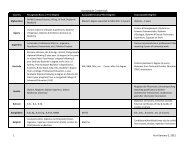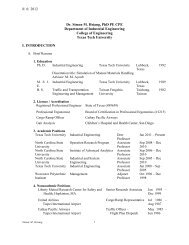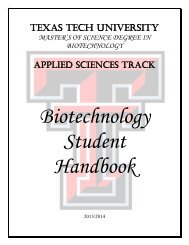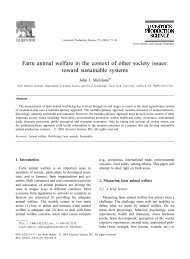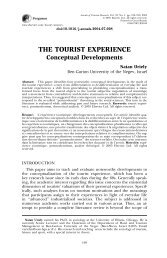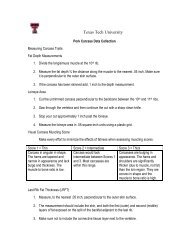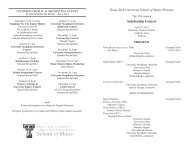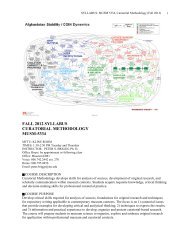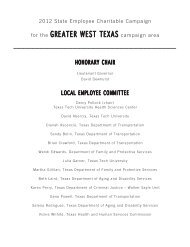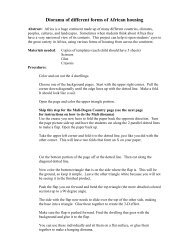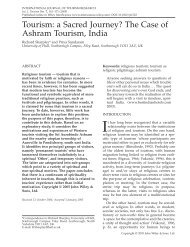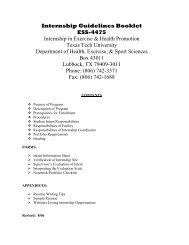PHY 1A - Texas Tech University
PHY 1A - Texas Tech University
PHY 1A - Texas Tech University
Create successful ePaper yourself
Turn your PDF publications into a flip-book with our unique Google optimized e-Paper software.
<strong>Texas</strong> Essential Knowledge and Skills<br />
Physics 1<br />
§112.39. Physics, Beginning with School Year 2010-2011 (One Credit).<br />
(a) General requirements. Students shall be awarded one credit for successful completion of this course. Algebra I is suggested as a<br />
prerequisite or co-requisite. This course is recommended for students in Grade 9, 10, 11, or 12.<br />
(b) Introduction.<br />
(1) Physics. In Physics, students conduct laboratory and field investigations, use scientific methods during investigations, and make<br />
informed decisions using critical thinking and scientific problem solving. Students study a variety of topics that include: laws of motion;<br />
changes within physical systems and conservation of energy and momentum; forces; thermodynamics; characteristics and behavior of<br />
waves; and atomic, nuclear, and quantum physics. Students who successfully complete Physics will acquire factual knowledge within a<br />
conceptual framework, practice experimental design and interpretation, work collaboratively with colleagues, and develop critical<br />
thinking skills.<br />
(2) Nature of science. Science, as defined by the National Academy of Sciences, is the "use of evidence to construct testable<br />
explanations and predictions of natural phenomena, as well as the knowledge generated through this process." This vast body of<br />
changing and increasing knowledge is described by physical, mathematical, and conceptual models. Students should know that some<br />
questions are outside the realm of science because they deal with phenomena that are not scientifically testable.<br />
(3) Scientific inquiry. Scientific inquiry is the planned and deliberate investigation of the natural world. Scientific methods of<br />
investigation can be experimental, descriptive, or comparative. The method chosen should be appropriate to the question being asked.<br />
(4) Science and social ethics. Scientific decision making is a way of answering questions about the natural world. Students should be<br />
able to distinguish between scientific decision-making methods and ethical and social decisions that involve the application of scientific<br />
information.<br />
(5) Scientific systems. A system is a collection of cycles, structures, and processes that interact. All systems have basic properties that<br />
can be described in terms of space, time, energy, and matter. Change and constancy occur in systems as patterns and can be observed,<br />
measured, and modeled. These patterns help to make predictions that can be scientifically tested. Students should analyze a system in<br />
terms of its components and how these components relate to each other, to the whole, and to the external environment.<br />
(c) Knowledge and skills.<br />
(1) Scientific processes. The student conducts investigations, for at least 40% of instructional time, using safe, environmentally<br />
appropriate, and ethical practices. These investigations must involve actively obtaining and analyzing data with physical equipment, but<br />
may also involve experimentation in a simulated environment as well as field observations that extend beyond the classroom. The<br />
student is expected to:<br />
(A) demonstrate safe practices during laboratory and field investigations; and<br />
(B) demonstrate an understanding of the use and conservation of resources and the proper disposal or recycling of materials.<br />
(2) Scientific processes. The student uses a systematic approach to answer scientific laboratory and field investigative questions. The<br />
student is expected to:<br />
(A) know the definition of science and understand that it has limitations, as specified in subsection (b)(2) of this section;<br />
(B) know that scientific hypotheses are tentative and testable statements that must be capable of being supported or not supported by<br />
observational evidence. Hypotheses of durable explanatory power which have been tested over a wide variety of conditions are<br />
incorporated into theories;<br />
(C) know that scientific theories are based on natural and physical phenomena and are capable of being tested by multiple independent<br />
researchers. Unlike hypotheses, scientific theories are well-established and highly-reliable explanations, but may be subject to change as<br />
new areas of science and new technologies are developed;<br />
(D) distinguish between scientific hypotheses and scientific theories;<br />
(E) design and implement investigative procedures, including making observations, asking well-defined questions, formulating testable<br />
hypotheses, identifying variables, selecting appropriate equipment and technology, and evaluating numerical answers for<br />
reasonableness;<br />
(F) demonstrate the use of course apparatus, equipment, techniques, and procedures, including multimeters (current, voltage,<br />
resistance), triple beam balances, batteries, clamps, dynamics demonstration equipment, collision apparatus, data acquisition probes,<br />
discharge tubes with power supply (H, He, Ne, Ar), hand-held visual spectroscopes, hot plates, slotted and hooked lab masses, bar<br />
magnets, horseshoe magnets, plane mirrors, convex lenses, pendulum support, power supply, ring clamps, ring stands, stopwatches,<br />
trajectory apparatus, tuning forks, carbon paper, graph paper, magnetic compasses, polarized film, prisms, protractors, resistors, friction<br />
blocks, mini lamps (bulbs) and sockets, electrostatics kits, 90-degree rod clamps, metric rulers, spring scales, knife blade switches,<br />
Celsius thermometers, meter sticks, scientific calculators, graphing technology, computers, cathode ray tubes with horseshoe magnets,<br />
ballistic carts or equivalent, resonance tubes, spools of nylon thread or string, containers of iron filings, rolls of white craft paper, copper<br />
wire, Periodic Table, electromagnetic spectrum charts, slinky springs, wave motion ropes, and laser pointers;<br />
3



